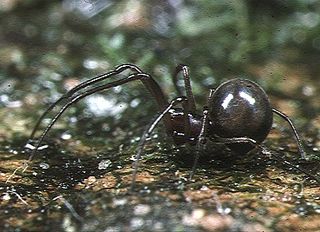
The family Dipluridae, known as curtain-web spiders are a group of spiders in the infraorder Mygalomorphae, that have two pairs of booklungs, and chelicerae (fangs) that move up and down in a stabbing motion. A number of genera, including that of the Sydney funnel-web spider (Atrax), used to be classified in this family but have now been moved to Atracidae.

The Mesothelae are a suborder of spiders. As of April 2024, two extant families were accepted by the World Spider Catalog, Liphistiidae and Heptathelidae. Alternatively, the Heptathelidae can be treated as a subfamily of a more broadly circumscribed Liphistiidae. There are also a number of extinct families.

The spider family Liphistiidae was first recognized by Tamerlan Thorell in 1869. When narrowly circumscribed, it comprises a single genus Liphistius, native to Southeast Asia; as of April 2024, this was the circumscription accepted by the World Spider Catalog. The family contains the most basal living spiders, belonging to the suborder Mesothelae. The family has also been circumscribed more broadly to include the family Heptathelidae as a subfamily, Heptathelinae, with the narrowly circumscribed Liphistiidae becoming the subfamily Liphistiinae.

Scaffold web spiders or cave cobweb spiders (Nesticidae) are a family of araneomorph spiders closely allied with tangle-web spiders (Theridiidae). Like the Theridiidae, these spiders have a comb of serrated bristles on the hind tarsi that are used to pull silk bands from the spinnerets. Nesticidae contains 16 genera and about 300 species, many of which are associated with caves or overhangs. The genus Nesticus is the type for the family and is found throughout the world. The related Eidmannella has speciated considerably in Texas caves and includes some extremely localized species that are considered threatened. One species, Eidmannella pallida, is found in caves and under overhangs, but also in agricultural fields and other habitats away from such restricted areas. The genus Carpathonesticus is found in central Eurasia.

Anapidae is a family of rather small spiders with 232 described extant species in 58 genera. It includes the former family Micropholcommatidae as the subfamily Micropholcommatinae, and the former family Holarchaeidae. Most species are less than 2 millimetres (0.079 in) long.

Archaeidae, also known as assassin spiders and pelican spiders, is a spider family with about ninety described species in five genera. It contains small spiders, ranging from 2 to 8 millimetres long, that prey exclusively on other spiders. They are unusual in that they have "necks", ranging from long and slender to short and thick. The name "pelican spider" refers to these elongated jaws and necks used to catch their prey. Living species of Archaeidae occur in South Africa, Madagascar and Australia, with the sister family Mecysmaucheniidae occurring in southern South America and New Zealand.

Rugathodes is a genus of comb-footed spiders that was first described by Allan Frost Archer in 1950. It is closely related to members of Theridion and Wamba.
Spermophorides is a genus of cellar spiders that was first described by J. Wunderlich in 1992.

Phrurolithidae is a family of araneomorph spiders, known as guardstone spiders. The family was first described by Nathan Banks in 1892. First included in the Corinnidae as the subfamily Phrurolithinae, later phylogenetic studies justified a separate family.

Megalepthyphantes is a genus of dwarf spiders that was first described by J. Wunderlich in 1994.
Canariellanum is a genus of European dwarf spiders that was first described by J. Wunderlich in 1987.
Canariphantes is a genus of dwarf spiders that was first described by J. Wunderlich in 1992. It might be a junior synonym of Lepthyphantes.

Parapelecopsis is a genus of dwarf spiders that was first described by J. Wunderlich in 1992. The spider is found in woodlands in leaf litter, pine needles, moss at ground level and lichen and moss on tree trunks.
Savigniorrhipis is a genus of Portuguese sheet weavers that was first described by J. Wunderlich in 1992. As of May 2019 it contains only two species, both found on the Azores: S. acoreensis and S. topographicus.
Eurypoena is a monotypic genus of comb-footed spiders containing the single species, Eurypoena tuberosa. The species was first described by J. Wunderlich in 1992 who then created the genus in 1992. It is found on the Canary Islands.

Physoglenidae is a family of araneomorph spiders first described by Alexander Petrunkevitch in 1928 as a subfamily of Pholcidae. It was later moved to Synotaxidae until a study in 2016 showed that they formed a distinct clade.
Phruronellus is a genus of North American araneomorph spiders first described by R. V. Chamberlin in 1921. Originally placed with the Liocranidae, it was moved to the Corinnidae in 2002, and to the Phrurolithidae in 2014.
Piabuna is a genus of North American araneomorph spiders first described by R. V. Chamberlin & Wilton Ivie in 1933. Originally added to the Liocranidae, it was moved to the Corinnidae in 2002, then to the Phrurolithidae in 2014.
Phrurolinillus is a genus of European araneomorph spiders first described by Jörg Wunderlich in 1995. Originally placed with the Corinnidae, it was moved to the Phrurolithidae in 2014. As of April 2019 it contains only two species from the Iberian Peninsula.
Lingulatus is a genus of araneomorph spiders in the family Phrurolithidae. It was first described by Mu & Zhang in 2022.











